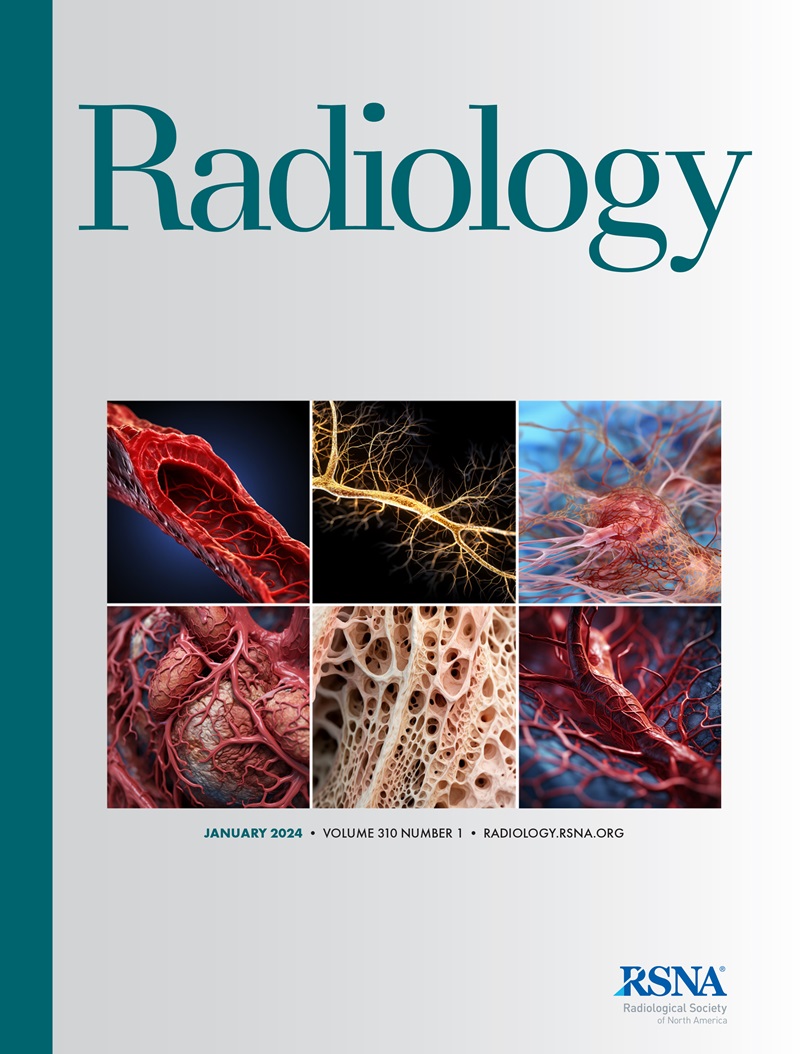A Safe MRI- and PET-guided Method for Increasing Osmotic Blood-Brain Barrier Permeability.
IF 15.2
1区 医学
Q1 RADIOLOGY, NUCLEAR MEDICINE & MEDICAL IMAGING
引用次数: 0
Abstract
Background Given the current lack of widely adopted strategies for facilitating drug penetration into the brain, developing new techniques to increase blood-brain barrier (BBB) permeability is essential to address the increasing burden of central nervous system disorders. Osmotic blood-brain barrier opening (OBBBO), achieved through intra-arterial delivery of 25% mannitol to the cerebral vasculature, is a pioneering strategy demonstrating both safety and partial efficacy. Purpose To investigate the potential of 25% mannitol with 4% NaCl, a combination that doubles the osmotic power, to safely increase OBBBO efficacy. Materials and Methods To visualize penetration into the brain, OBBBO with intra-arterial, intravenous, or intraperitoneal infusion of molecules was performed in mice (n = 44). Brain penetration of small molecules (gadolinium-based contrast agent) and the safety of the infusion procedure were assessed via MRI and histologic examination. Brain penetration of large molecules (zirconium 89-radiolabeled antibodies) was assessed via PET imaging. A head-to-head comparison was performed of brain penetration of both these molecules using the standard approach (25% mannitol) versus the combination of 25% mannitol with 4% NaCl. The Wilcoxon signed rank test, Mann-Whitney U test, and mixed-model analysis were used for the statistical analyses. Results The findings showed robust OBBBO across the entire targeted hemisphere of mouse brains following administration of 4% NaCl in 25% mannitol (n = 9), surpassing that achieved with 25% mannitol alone (n = 8) (ratio of OBBBO area to intact BBB area, 1.99 ± 0.17 vs 1.41 ± 0.15; P < .001). Follow-up MRI and postmortem histologic examination confirmed the safety of this procedure. PET imaging revealed that brain uptake of radiolabeled antibodies was significantly improved using this new method. Conclusion Combining 4% NaCl with 25% mannitol showed promise for improving the safe delivery of therapeutic agents to the brain through the endovascular route. © RSNA, 2025 Supplemental material is available for this article. See also the editorial by Clement and Gaultier in this issue.一种安全的MRI和pet引导下增加血脑屏障渗透性的方法。
鉴于目前缺乏广泛采用的促进药物渗透到大脑的策略,开发新的技术来增加血脑屏障(BBB)的渗透性对于解决中枢神经系统疾病日益增加的负担至关重要。渗透性血脑屏障开放(OBBBO),通过动脉内输送25%甘露醇到脑血管系统,是一种开创性的策略,显示出安全性和部分有效性。目的探讨25%甘露醇与4% NaCl的组合可使渗透能力翻倍,安全提高OBBBO疗效的可能性。材料和方法在小鼠(n = 44)中进行了动脉、静脉或腹腔内输注分子的OBBBO,以观察渗透到大脑的情况。通过MRI和组织学检查评估小分子(钆基造影剂)脑渗透和输注过程的安全性。通过PET显像评估大分子(锆89-放射性标记抗体)的脑渗透。使用标准方法(25%甘露醇)和25%甘露醇与4% NaCl的组合对这两种分子的脑穿透进行了头对头的比较。采用Wilcoxon符号秩检验、Mann-Whitney U检验和混合模型分析进行统计分析。结果25%甘露醇(n = 9)中4% NaCl处理后,小鼠靶脑半球出现了明显的脑卒中区(OBBBO),超过单独25%甘露醇处理(n = 8) (OBBBO面积与完整脑卒中区面积之比,1.99±0.17 vs 1.41±0.15,P < 0.001)。后续的MRI和死后组织学检查证实了该手术的安全性。PET显像显示,使用这种新方法,大脑对放射性标记抗体的摄取显着改善。结论4% NaCl联合25%甘露醇可提高药物经血管内给药的安全性。©RSNA, 2025本文可获得补充材料。参见克莱门特和高缇耶在本期的社论。
本文章由计算机程序翻译,如有差异,请以英文原文为准。
求助全文
约1分钟内获得全文
求助全文
来源期刊

Radiology
医学-核医学
CiteScore
35.20
自引率
3.00%
发文量
596
审稿时长
3.6 months
期刊介绍:
Published regularly since 1923 by the Radiological Society of North America (RSNA), Radiology has long been recognized as the authoritative reference for the most current, clinically relevant and highest quality research in the field of radiology. Each month the journal publishes approximately 240 pages of peer-reviewed original research, authoritative reviews, well-balanced commentary on significant articles, and expert opinion on new techniques and technologies.
Radiology publishes cutting edge and impactful imaging research articles in radiology and medical imaging in order to help improve human health.
 求助内容:
求助内容: 应助结果提醒方式:
应助结果提醒方式:


